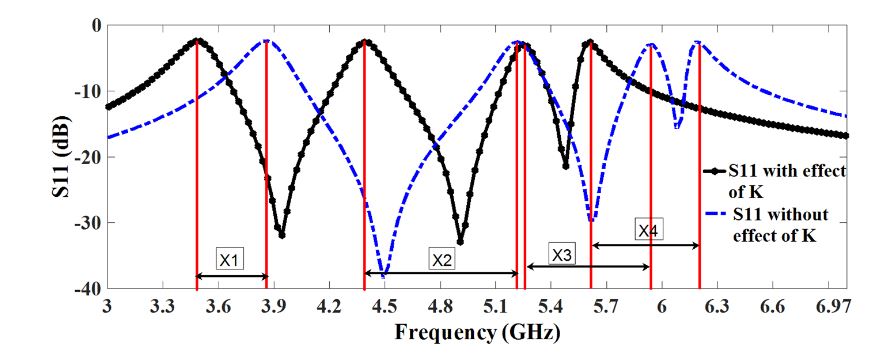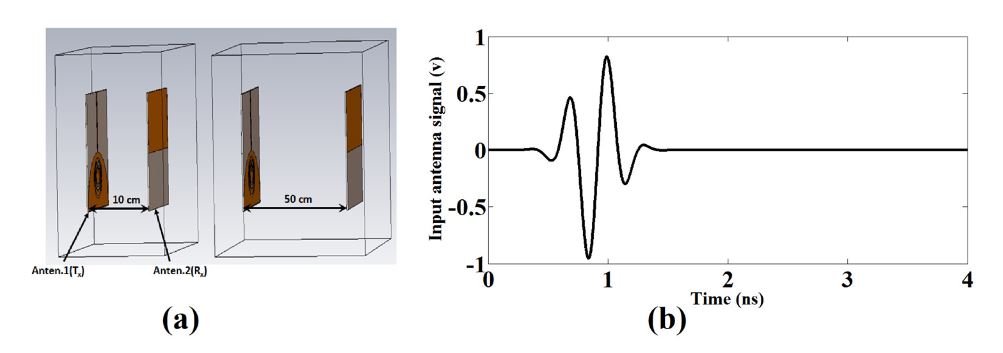ABSTRACT
We present a compact ultra-wideband (UWB) antenna integrated with sharp notches with a detailed analysis of the mutual coupling of the multiple notch resonators. By utilizing complementary split ring resonators (CSRR) on the radiating semi-circular patch, we achieve the sharp notch-filtering of various bands within the UWB band without increasing the antenna size. The notched frequency bands include WiMAX, INSAT, and lower and upper WLAN.
In order to estimate the frequency shifts of the notch due to the coupling of the nearby CSRRs, an analysis of the coupling among the multiple notch resonators is carried out and we construct the lumped-circuit equivalent model. The time domain analysis of the proposed antenna is performed to show its validity on the UWB application. The measured frequency response of the input port corresponds quite well with the calculations and simulations. The radiation pattern of the implemented quad-notched UWB antenna is nearly omnidirectional in the passband.
DESIGN AND SIMULATION RESULTS

Figure 1. Geometry of the proposed antenna, (a) Magnified view of the CSRR, (b) Front View, (c) Rear-View, and (d) Realized prototype
Around the designed notch-frequencies, the radiation is obstructed, and antenna input impedance becomes drastically different from that in the passband. The optimal position of the CSRRs is judged based on the surface current distribution analysis. At notch frequencies, the current flows are more dominating around the resonant structures. Dimensions of the proposed antenna are presented in Table 1 and illustrated in Figure 1.
ANALYSIS OF QUAD-NOTCHED ANTENNA WITH CSRR-TO-CSRR COUPLING

Figure 4. Corresponding shift in the frequency response of each rejection band caused by coupling effect
After applying the above-generalized technique, the effect of antenna response is observed with and without coupling. It shows that there exists a significant amount of coupling among the CSRR elements and the corresponding shift in the frequency is presented in Table 2 as well as Figure 4. The INSAT and lower WLAN resonator elements are placed in the middle where we can observe a strong coupling between these two resonators.
TIME DOMAIN BEHAVIOR OF THE PROPOSED ANTENNA

Figure 7. (a) Setup of the proposed antenna at two different distance (b) Input pulse selected for the excitation of the proposed antenna
Figure 7a shows the setup that uses the two identical antennas, one acting as a transmitter (Tx) and another as a receiver (Rx) where the transmitting antenna is fixed while the receiving antenna has been moved to 10 cm, 30 cm and 50 cm. The antennas are excited using the 5th order Gaussian pulse which essentially satisfies the FCC spectral mask for UWB communications.
MEASUREMENTS

Figure 11. Simulated vs. measured radiation pattern of the proposed antenna (a) 3.8 GHz (b) 4.9 GHz (c) 6.24 GHz (d) 8.15 GHz
The chamber is equipped with the near-field planner scanner and a far-field tower to test and measure the radiation pattern of the antenna under test (AUT). We measured the co-polarized beam patterns at 3.8, 4.9, 6.24 and 8.1 GHz which cover most of the wireless interferences at lower, upper, and mid frequencies of the UWB and the measured radiation patterns show nearly omnidirectional as expected as presented in Figure 11.
COMPARISON WITH RECENTLY PROPOSED DESIGNS
We compared the proposed UWB antenna with other recently reported UWB antennas in the literature. Table 5 reveals that there is a distinct trade-off between the antenna size and the performance of filtering of the UWB antenna, owing to the coupling effect. Moreover, miniaturization also causes a degraded radiation pattern as well as low radiation efficiency.
With this regard, the proposed technique has a distinct advantage over other state of the art designs in the context of the increased number of the multiple notches with compact size as this technique consumes less space owing to the careful analysis of their mutual coupling effect. The proposed antenna also exhibits a stable radiation pattern and wide bandwidth over the whole range of UWB passband.
CONCLUSIONS
A compact UWB antenna having quad-notched bands was presented. The quad-notched bands were obtained by integrating four compact CSRRs on a semi-circular radiating patch. The antenna was designed to operate as an RF sensor or to be installed in portable UWB devices. The corresponding mutual couplings among each CSRR were analyzed with the help of the Babinet principle. With this approach, the frequency shift of the notches caused by the strong coupling among the CSRRs was evaluated.
Moreover, an equivalent circuit of the proposed antenna was derived, while a UWB time domain analysis was performed to check its validity in practical applications. The measurements carried out on an antenna prototype match well with the numerical simulations. In conclusion, the proposed antenna is widely applicable in the field of UWB communications and sensing applications owing to its compactness with multi-band notches.
Source: Dongguk University
Authors: MuhibUr Rahman | Dong-Sik Ko | Jung-Dong Park
>> 60+ Antenna Communication Projects for Engineering Students